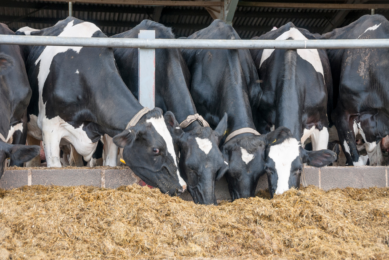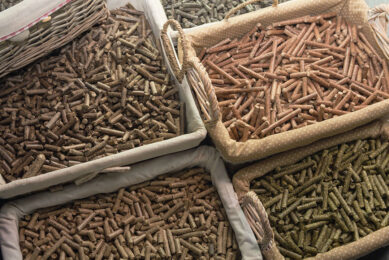Use of organic acids in feed and raw materials

When pathogenic bacteria contaminate feed, it becomes a potential route of transmission of disease to animal and human populations, and is consequently of great concern to producers and consumers. Food-producing animals are the main reservoirs for many of these micro-organisms. Organics acids are a valuable tool to prevent pathogens from recontaminating feeds.
By Renata Urbaityte, Biomin, Herzogenburg, Austria
Prevention of disease transmission and enhancement of growth and feed efficiency are critical factors in modern animal production.
The microflora found in feed materials comes from a variety of ecological niches e.g. soil and the animals’ gastrointestinal (GI) tract. The GI tract pathogens can be introduced into the food chain by animals defecating in the farm environment or by fertilisation of crops with manures, consequentially making feed a carrier for animal and human pathogens.
Feed materials may be inoculated with micro-organisms, mostly bacteria and fungi, at any time during growing, harvesting, processing and storage.
Counts of micro-organisms vary depending on the function of materials, location of its origin and climatic conditions. It is known that microfloral growth is dependent on moisture, pH value, temperature and composition of feed materials. For example, the optimal temperature forE. coliO157:H7 is 37°C, with a minimum of 7-8°C and a maximum of 46°C. The optimal pH is between 6 and 7, however it might stand a pH range between 4.4 to 9.0. TheE. coliO157:H7 doubles in number approximately every 24 minutes at the optimal temperature and pH value.
Bacterial growth in dry feeds
Some micro-organisms includingE. colimay adapt to conditions without water and can actively grow in stored feed. Some authors reported that grains and oilseed crops possess a diverse microflora, with populations ranging from 5,000 to 160 million colony-forming units (CFU)/g that are highly resistant to low moisture conditions.
The orientation values of mesophilic bacteria, includingListeria monocytogenes, Pesudomonas maltophilia, Thiobacillus novellus, Staphylococcus aureus, Streptococcus pyrogenes, Streptococcus pneumoniae, E. coliandClostridium kluyveri,etc. for swine compound feed are shown in Table 1. Experimentally, very low doses ofE. coliO157:H7 may result in colonisation of some piglets. Once some piglets are colonised, they may amplify E. coliO157:H7 and transmit it to other piglets via contact. EnterotoxigenicE. colistrains are a major cause of diarrhoea and death in neonatal and newly weaned pigs. EnterotoxigenicE. coliadhere to the small intestinal microvilli and produce enterotoxins that act locally on enterocytes. This action results in hypersecretion of water and electrolytes, and reduced absorption.
Organic acids after heat treatment
Heat treatment, usually during conditioning, pelleting or extrusion has been shown to be an effective way to reduce microbial loads in feed materials and compound feed.
Reduction of the bacterial contamination by heat is dependent on the temperature and treatment time.
However, these methods do not prevent a recontamination of feed materials and compound feed afterwards. Dietary acidification with organic acids has been shown to contribute to environmental hygiene preventing feed raw materials and compound feed from microbial and fungal deterioration.
Moreover, constant treatment with organic acids has a residual protective effect in feed, which helps to reduce recontamination and also to reduce the contamination of milling and feeding equipment as well.
Supplementation of organic acids in feed tends to decrease the feed pH, buffer capacity and to prevent undesirable microbes’ growth. However, for each acid, its specific inhibiting effect on bacteria, yeast and mould has to be considered when recommendations for feed supplementation are made. For example, some organic acids, like formic and propionic acids, have broader antimicrobial activities and can be effective against bacteria and fungi, including yeast.
Dietary acidification is important to create unfavourable conditions for micro-organisms and for reduction of pH and stimulation of GI tract enzymes.
Optimum pH is needed for enzyme activation, for example, pepsinogens are rapidly activated at pH 2, but very slow at pH 4. Pepsin has its optimum between pH 2 and 3.6, and remains inactive at pH 6.
Piglets benefit more
Due to insufficient production of HCl and pancreatic enzymes, and sudden changes in feed consistency and intake, piglets have limited digestive capacity and absorption at weaning. Moreover, the stress associated with weaning is known to disturb the intestinal microflora. Various studies show that acidification of the diets decreased pH-value in feed and consequentially reduced the coliform andE. colicounts along the intestinal tract, decreasing scouring and mortality of piglets. It has been shown that acid conditions favour the growth of lactobacilli in the stomach, which possibly inhibits the proliferation ofE. coliand produces lactic acid and other metabolites which lower the pH and inhibitE. coli.
The reported pH levels of the swine diets in these studies range from 4.36 to 5.79. Dietary acidification by a mixture of organic acids decreased the pH value in swine diets by 0.15 to 0.98 pH units.
The decrease in pH values was dependent on the inclusion levels of organic acids, which varied from 0.5 to 3%, and composition of the diet. This was in agreement with our study, where a blend of formic and propionic acids (BiotronicSRTmSE forte) at an inclusion level of 0.3% reduced the pH by 0.11 pH units in starter and grower diets. A higher inclusion level of 0.5% of the same acid blend reduced pH of the diet by 0.23 and 0.21 pH units in the starter and grower diets, respectively. The pH and B-values of starter and grower feed are shown in Table 2.
Buffering capacity of diets
Another factor affecting the response of acidifiers would be the buffering capacity of the diets. By definition, the buffering capacity (B-value) is the change in the pH value of a defined volume or mass after the addition of a strong acid.
A more practical definition in the feed industry is that the B-value is the amount of 1Mhydrochloric acid (HCl) solution which needs to be added to a 10% slurry of feed or a feed ingredient in 100 ml of water in order to obtain a pH-value of 5, in some cases a pH value of 4 or 3.
This definition is the reason why we find different values for the same expression in practical applications. For example, various studies reported B-values ranging from 380 to 700 mEq per kg feed.
Acid-buffering capacity is lowest in cereals and cereal by-products, intermediate or high in protein feedstuffs and very high in minerals. It might be reasonable to assume that the buffering capacity of pig feed can be considerably influenced by selection of feed ingredients, and it may in part result in differences in the effectiveness of acidifiers. It is recommended that swine diets should not exceed 700 mEq/kg of feed B-value.
High protein and mineral content of feed ensures rapid animal growth, but generates high buffering capacity, thus reducing levels of HCl in the stomach.
Results of some studies demonstrated that high B-value of the diet increased gastric pH and resulted in decreased amino acids digestibility.
Lowering dietary buffering capacity, via acidification with organic acids, has been shown to inhibit luminal growth of enterotoxigenic microflora and to enhance swine performance. Results of anin vitrostudy showed that an acidifier consisting of a blend of formic and propionic acids at an inclusion level of 0.3% decreased B-value by 16 and 17% in starter and grower pig diets, respectively. Moreover, the inclusion level of 0.5% of the same acid blend decreased B-value by 18 and 19% in starter and grower pig diets, respectively. The decrease in B-value was directly related to the inclusion level of acidifier and the diet composition.
Powerful tools
Acidifiers are powerful tools to maintain animal health and improve their performance, as well as to control feed and environmental hygiene.
Consistent beneficial effects on productivity in weaned pigs have been reported in numerous scientific studies with results showing the decreased microbial counts in feed and improved animal growth performance, reduced diarrhoea, morbidity and mortality rates.
Furthermore, an overwhelming portion of livestock producers consider acidifiers as an outstanding solution to enhance performance and, therefore, profitability.
References can be obtained from the author at
Source: Feed Tech magazine Volume 13. No 6











